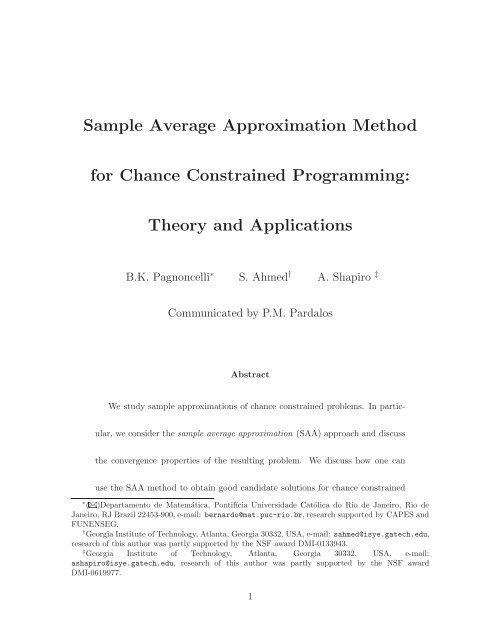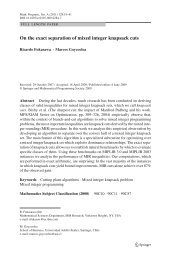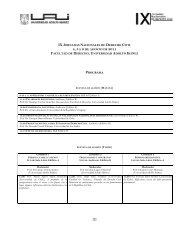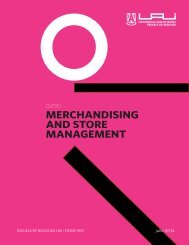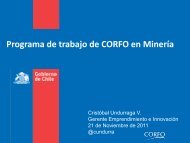Sample Average Approximation Method for Chance Constrained ...
Sample Average Approximation Method for Chance Constrained ...
Sample Average Approximation Method for Chance Constrained ...
- No tags were found...
You also want an ePaper? Increase the reach of your titles
YUMPU automatically turns print PDFs into web optimized ePapers that Google loves.
<strong>Sample</strong> <strong>Average</strong> <strong>Approximation</strong> <strong>Method</strong><strong>for</strong> <strong>Chance</strong> <strong>Constrained</strong> Programming:Theory and ApplicationsB.K. Pagnoncelli ∗ S. Ahmed † A. Shapiro ‡Communicated by P.M. PardalosAbstractWe study sample approximations of chance constrained problems. In particular,we consider the sample average approximation (SAA) approach and discussthe convergence properties of the resulting problem. We discuss how one canuse the SAA method to obtain good candidate solutions <strong>for</strong> chance constrained∗ ( )Departamento de Matemática, Pontifícia Universidade Católica do Rio de Janeiro, Rio deJaneiro, RJ Brazil 22453-900, e-mail: bernardo@mat.puc-rio.br, research supported by CAPES andFUNENSEG.† Georgia Institute of Technology, Atlanta, Georgia 30332, USA, e-mail: sahmed@isye.gatech.edu,research of this author was partly supported by the NSF award DMI-0133943.‡ Georgia Institute of Technology, Atlanta, Georgia 30332, USA, e-mail:ashapiro@isye.gatech.edu, research of this author was partly supported by the NSF awardDMI-0619977.1
problems. Numerical experiments are per<strong>for</strong>med to correctly tune the parametersinvolved in the SAA. In addition, we present a method <strong>for</strong> constructing statisticallower bounds <strong>for</strong> the optimal value of the considered problem and discuss how oneshould tune the underlying parameters. We apply the SAA to two chance constrainedproblems. The first is a linear portfolio selection problem with returnsfollowing a multivariate lognormal distribution. The second is a joint chanceconstrained version of a simple blending problem.Key words: <strong>Chance</strong> constraints, <strong>Sample</strong> average approximation, Portfolio selection.1 IntroductionWe consider chance constrained problems of the <strong>for</strong>mminx∈X f(x), s.t. prob{ G(x, ξ) ≤ 0 } ≥ 1 − α. (1)Here X ⊂ R n , ξ is a random vector 1 with probability distribution P supported on aset Ξ ⊂ R d , α ∈ (0, 1), f : R n → R is a real valued function and G : R n × Ξ → R m .<strong>Chance</strong> constrained problems were introduced in Charnes, Cooper and Symmonds [1]1 We use the same notation ξ to denote a random vector and its particular realization. Which ofthese two meanings will be used in a particular situation will be clear from the context.2
distribution in chance constraint by an empirical distribution corresponding to a randomsample. This approach is well known <strong>for</strong> stochastic programs with expected valuesobjectives [9]. SAA methods <strong>for</strong> chance constrained problems have been investigatedin [10] and [11].The remainder of the paper is organized as follows. In Section 2 we provide theoreticalbackground <strong>for</strong> the SAA approach, showing convergence of the optimal value of theapproximation to the optimal value of the true problem. In addition, following [8] wedescribe how to construct bounds <strong>for</strong> the optimal value of chance constrained problemsof the <strong>for</strong>m (1). In Section 3, we present a chance constrained portfolio selection problem.We apply the SAA method to obtain upper bounds as well as candidate solutionsto the problems. In addition we present several numerical experiments that indicatehow one should tune the parameters of the SAA approach. In Section 4 we presenta simple blending problem modeled as a joint chance constrained problem. Section 5concludes the paper and suggests directions <strong>for</strong> future research.We use the following notation throughout the paper. The integer part of numbera ∈ R is denoted by ⌊a⌋. By Φ(z) we denote the cumulative distribution function (cdf)of standard normal random variable and by z α the corresponding critical value, i.e.,4
Φ(z α ) = 1 − α, <strong>for</strong> α ∈ (0, 1),B(k; p, N) := ∑ k( N)i=0 i p i (1 − p) N−i , k = 0, ..., N, (2)denotes the cdf of binomial distribution. For sets A, B ⊂ R n we denote byD(A, B) := sup x∈A dist(x, B) (3)the deviation of set A from set B.2 Theoretical BackgroundIn order to simplify the presentation we assume in this section that the constraintfunction G : R n ×Ξ → R is real valued. Of course, a number of constraints G i (x, ξ) ≤ 0,i = 1, . . .,m, can be equivalently replaced by one constraint withG(x, ξ) := max1≤i≤m G i(x, ξ) ≤ 0.Such operation of taking maximum preserves convexity of functions G i (·, ξ). We assumethat the set X is closed, the function f(x) is continuous and the function G(x, ξ) is a5
Carathéodory function, i.e., G(x, ·) is measurable <strong>for</strong> every x ∈ R n and G(·, ξ) continuous<strong>for</strong> a.e. ξ ∈ Ξ.Problem (1) can be written in the following equivalent <strong>for</strong>mmin f(x), s.t. p(x) ≤ α, (4)x∈Xwherep(x) := P {G(x, ξ) > 0}.Now let ξ 1 , . . .,ξ N be an independent identically distributed (iid) sample of N realizationsof random vector ξ and P N := N −1 ∑ Nj=1 ∆(ξj ) be the respective empiricalmeasure. Here ∆(ξ) denotes measure of mass one at point ξ, and hence P N is a discretemeasure assigning probability 1/N to each point ξ j , j = 1, . . .,N. The sample averageapproximation ˆp N (x) of function p(x) is obtained by replacing the ‘true’ distribution Pby the empirical measure P N . That is, ˆp N (x) := P N {G(x, ξ) > 0}. Let 1l (0,∞) : R → Rbe the indicator function of (0, ∞), i.e.,⎧⎪⎨1l (0,∞) (t) :=⎪⎩1, if t > 0,0, if t ≤ 0.6
Then we can write that p(x) = E P [1l (0,∞) (G(x, ξ))] andˆp N (x) = E PN [1l (0,∞) (G(x, ξ))] = 1 NN∑ (1l (0,∞) G(x, ξ j ) ) .j=1That is, ˆp N (x) is equal to the proportion of times that G(x, ξ j ) > 0. The problem,associated with the generated sample ξ 1 , . . .,ξ N , ismin f(x), s.t. ˆp N(x) ≤ γ. (5)x∈XWe refer to problems (4) and (5) as the true and SAA problems, respectively, at therespective significance levels α and γ. Note that, following [11], we allow the significancelevel γ ≥ 0 of the SAA problem to be different from the significance level α of the trueproblem. Next we discuss the convergence of a solution of the SAA problem (5) to thatof the true problem (4) with respect to the sample size N and the significance level γ.A convergence analysis of the SAA problem (5) has been given in [11]. Here we presentcomplementary results under slightly different assumptions.Recall that a sequence f k (x) of extended real valued functions is said to epiconvergeto a function f(x), written f k e → f, if <strong>for</strong> any point x the following two conditions hold:7
(i) <strong>for</strong> any sequence x k converging to x one haslim infk→∞ f k(x k ) ≥ f(x), (6)(ii) there exists a sequence x k converging to x such thatlim sup f k (x k ) ≤ f(x). (7)k→∞Note that by the (strong) law of large numbers (LLN) we have that <strong>for</strong> any x, ˆp N (x)converges w.p.1 to p(x).Proposition 2.1 Let G(x, ξ) be a Carathéodory function. Then the functions p(x) andˆp N (x) are lower semicontinuous, and ˆp Ne → p w.p.1. Moreover, suppose that <strong>for</strong> every¯x ∈ X the set {ξ ∈ Ξ : G(¯x, ξ) = 0} has P-measure zero, i.e., G(¯x, ξ) ≠ 0 w.p.1.Then the function p(x) is continuous at every x ∈ X and ˆp N (x) converges to p(x) w.p.1uni<strong>for</strong>mly on any compact set C ⊂ X, i.e.,sup |ˆp N (x) − p(x)| → 0 w.p.1 as N → ∞. (8)x∈CProof. Consider function ψ(x, ξ) := 1l (0,∞)(G(x, ξ)). Recall that p(x) = EP [ψ(x, ξ)]8
and ˆp N (x) = E PN [ψ(x, ξ)]. Since the function 1l (0,∞) (·) is lower semicontinuous andG(·, ξ) is a Carathéodory function, it follows that the function ψ(x, ξ) is random lowersemicontinuous 2 (see, e.g., [12, Proposition 14.45]). Then by Fatou’s lemma we have<strong>for</strong> any ¯x ∈ R n ,lim inf x→¯x p(x) = lim inf x→¯x ψ(x, ξ)dP(ξ)∫Ξ≥ ∫ lim inf Ξ x→¯x ψ(x, ξ)dP(ξ) ≥ ∫ ψ(¯x, ξ)dP(ξ) = p(¯x).ΞThis shows lower semicontinuity of p(x). Lower semicontinuity of ˆp N (x) can be shownin the same way.The epiconvergence ˆp N e → p w.p.1 is a direct implication of Artstein and Wets [13,Theorem 2.3]. Note that, of course, |ψ(x, ξ)| is dominated by an integrable functionsince |ψ(x, ξ)| ≤ 1. Suppose, further, that <strong>for</strong> every ¯x ∈ X, G(¯x, ξ) ≠ 0 w.p.1, whichimplies that ψ(·, ξ) is continuous at ¯x w.p.1. Then by the Lebesgue Dominated ConvergenceTheorem we have <strong>for</strong> any ¯x ∈ X,lim x→¯x p(x) = lim x→¯x ψ(x, ξ)dP(ξ)∫Ξ= ∫ lim Ξ x→¯x ψ(x, ξ)dP(ξ) = ∫ ψ(¯x, ξ)dP(ξ) = p(¯x),Ξwhich shows continuity of p(x) at x = ¯x. Finally, the uni<strong>for</strong>m convergence (8) follows2 Random lower semicontinuous functions are called normal integrands in [12].9
y a version of the uni<strong>for</strong>m law of large numbers (see, [9, Proposition 7, p.363]).By lower semicontinuity of p(x) and ˆp N (x) we have that the feasible sets of the‘true’ problem (4) and its SAA counterpart (5) are closed sets. There<strong>for</strong>e, if the setX is bounded (i.e., compact), then problems (4) and (5) have nonempty sets of optimalsolutions denoted, respectively, as S and ŜN, provided that these problems havenonempty feasible sets. We also denote by ϑ ∗ and ˆϑ N the optimal values of the trueand the SAA problems, respectively. The following result shows that <strong>for</strong> γ = α, undermild regularity conditions, ˆϑ N and ŜN converge w.p.1 to their counterparts of the trueproblem.We make the following assumption.(A) There is an optimal solution ¯x of the true problem (4) such that <strong>for</strong> any ε > 0there is x ∈ X with ‖x − ¯x‖ ≤ ε and p(x) < α.In other words the above condition (A) assumes existence of a sequence {x k } ⊂ Xconverging to an optimal solution ¯x ∈ S such that p(x k ) < α <strong>for</strong> all k, i.e., ¯x is anaccumulation point of the set {x ∈ X : p(x) < α}.Proposition 2.2 Suppose that the significance levels of the true and SAA problems arethe same, i.e., γ = α, the set X is compact, the function f(x) is continuous, G(x, ξ) is10
a Carathéodory function, and condition (A) holds. Then ˆϑ N → ϑ ∗ and D(ŜN, S) → 0w.p.1 as N → ∞.Proof. By the condition (A), the set S is nonempty and there is x ∈ X such thatp(x) < α. We have that ˆp N (x) converges to p(x) w.p.1. Consequently ˆp N (x) < α, andhence the SAA problem has a feasible solution, w.p.1 <strong>for</strong> N large enough. Since ˆp N (·)is lower semicontinuous, the feasible set of SAA problem is compact, and hence ŜN isnonempty w.p.1 <strong>for</strong> N large enough. Of course, if x is a feasible solution of an SAAproblem, then f(x) ≥ ˆϑ N . Since we can take such point x arbitrary close to ¯x and f(·)is continuous, we obtain thatlim supN→∞ˆϑ N ≤ f(¯x) = ϑ ∗ w.p.1. (9)Now let ˆx N ∈ ŜN, i.e., ˆx N ∈ X, ˆp N (ˆx N ) ≤ α and ˆϑ N = f(ˆx N ). Since the set X iscompact, we can assume by passing to a subsequence if necessary that ˆx N converges toa point ¯x ∈ X w.p.1. Also we have that ˆp Ne → p w.p.1, and hencelim infN→∞ˆp N(ˆx N ) ≥ p(¯x) w.p.1.It follows that p(¯x) ≤ α and hence ¯x is a feasible point of the true problem, and thus11
f(¯x) ≥ ϑ ∗ . Also f(ˆx N ) → f(¯x) w.p.1, and hencelim infN→∞ˆϑ N ≥ ϑ ∗ w.p.1. (10)It follows from (9) and (10) that ˆϑ N → ϑ ∗ w.p.1. It also follows that the point ¯x is anoptimal solution of the true problem and then we have D(ŜN, S) → 0 w.p.1.Condition (A) is essential <strong>for</strong> the consistency of ˆϑ N and ŜN. Think, <strong>for</strong> example,about a situation where the constraint p(x) ≤ α defines just one feasible point ¯x suchthat p(¯x) = α. Then arbitrary small changes in the constraint ˆp N (x) ≤ α may result inthat the feasible set of the corresponding SAA problem becomes empty. Note also thatcondition (A) was not used in the proof of inequality (10). Verification of condition (A)can be done by ad hoc methods.Suppose now that γ > α. Then by Proposition 2.2 we may expect that with increaseof the sample size N, an optimal solution of the SAA problem will approach an optimalsolution of the true problem with the significance level γ rather than α. Of course,increasing the significance level leads to enlarging the feasible set of the true problem,which in turn may result in decreasing of the optimal value of the true problem. For apoint ¯x ∈ X we have that ˆp N (¯x) ≤ γ, i.e., ¯x is a feasible point of the SAA problem, iff12
no more than γN times the event “G(¯x, ξ j ) > 0” happens in N trials. Since probabilityof the event “G(¯x, ξ j ) > 0” is p(¯x), it follows thatprob {ˆp N (¯x) ≤ γ } = B ( ⌊γN⌋; p(¯x), N ) . (11)Recall that by Chernoff inequality [14], <strong>for</strong> k > Np,B(k; p, N) ≥ 1 − exp { −N(k/N − p) 2 /(2p) } .It follows that if p(¯x) ≤ α and γ > α, then 1 − prob {ˆp N (¯x) ≤ γ } approaches zero ata rate of exp(−κN), where κ := (γ − α) 2 /(2α). Of course, if ¯x is an optimal solutionof the true problem and ¯x is feasible <strong>for</strong> the SAA problem, then ˆϑ N ≤ ϑ ∗ . That is, ifγ > α, then the probability of the event “ˆϑ N ≤ ϑ ∗ ” approaches one exponentially fast.Similarly, we have that if p(¯x) = α and γ < α, then probability that ¯x is a feasiblepoint of the corresponding SAA problem approaches zero exponentially fast (cf., [11]).In order to get a lower bound <strong>for</strong> the optimal value ϑ ∗ we proceed as follows. Let13
us choose two positive integers M and N, and letθ N := B ( ⌊γN⌋; α, N )and L be the largest integer such thatB(L − 1; θ N , M) ≤ β. (12)Next generate M independent samples ξ 1,m , . . .,ξ N,m , m = 1, . . ., M, each of size N, ofrandom vector ξ. For each sample solve the associated optimization problemNmin f(x), s.t.x∈X∑ (1l (0,∞) G(x, ξ j,m ) ) ≤ γN, (13)j=1and hence calculate its optimal value ˆϑ m N , m = 1, . . ., M. That is, solve M times thecorresponding SAA problem at the significance level γ. It may happen that problem(13) is either infeasible or unbounded from below, in which case we assign its optimalvalue as +∞ or −∞, respectively. We can view ˆϑ m N , m = 1, . . ., M, as an iid sample ofthe random variable ˆϑ N , where ˆϑ N is the optimal value of the respective SAA problemat significance level γ. Next we rearrange the calculated optimal values in the nonde-14
creasing order as followsˆϑ(1)N≤ · · · ≤ ˆϑ(M)N, i.e., ˆϑ(1)N(2)is the smallest, ˆϑNis the secondsmallest etc, among the values ˆϑ m (L)N , m = 1, . . .,M. We use the random quantity ˆϑNasa lower bound of the true optimal value ϑ ∗ . It is possible to show that with probabilityat least 1 − β, the random quantityˆϑ(L)Nis below the true optimal value ϑ∗ , i.e.,ˆϑ(L)Nis indeed a lower bound of the true optimal value with confidence at least 1 − β (see 3[8]). We will discuss later how to choose the constants M, N and γ.3 A <strong>Chance</strong> <strong>Constrained</strong> Portfolio ProblemConsider the following maximization problem subject to a single chance constraintmax E[ r T x ] , s.t. prob { r T x ≥ v } ≥ 1 − α. (14)x∈XHere x ∈ R n is vector of decision variables, r ∈ R n is a random (data) vector (withknown probability distribution), v ∈ R and α ∈ (0, 1) are constants, e is a vector whosecomponents are all equal to 1 andX := {x ∈ R n : e T x = 1, x ≥ 0}.3 In [8] this lower bound was derived <strong>for</strong> γ = 0. It is straight<strong>for</strong>ward to extend the derivations tothe case of γ > 0.15
Note that, of course, E [ r T x ] = r T x, where r := E[r] is the corresponding mean vector.That is, the objective function of problemThe motivation to study (14) is the portfolio selection problem going back toMarkowitz [15]. The vector x represents the percentage of a total wealth of one dollarinvested in each of n available assets, r is the vector of random returns of theseassets and the decision agent wants to maximize the mean return subject to having areturn greater or equal to a desired level v, with probability at least 1 − α. We notethat problem (14) is not realistic because it does not incorporate crucial features ofreal markets such as cost of transactions, short sales, lower and upper bounds on theholdings, etc. However, it will serve to our purposes as an example of an application ofthe SAA method. For a more realistic model we can refer the reader, e.g., to [16].3.1 Applying the SAAFirst assume that r follows a multivariate normal distribution with mean vector r andcovariance matrix Σ, written r ∼ N (r, Σ). In that case r T x ∼ N ( r T x, x T Σx ) , andhence (as it is well known) the chance constraint in (14) can be written as a convexsecond order conic constraint (SOCC). Using the explicit <strong>for</strong>m of the chance constraint,one can efficiently solve the convex problem (14) <strong>for</strong> different values of α. An efficient16
frontier of portfolios can be constructed in an objective function value versus confidencelevel plot, that is, <strong>for</strong> every confidence level α we associate the optimal value of problem(14). The efficient frontier dates back to Markowitz [15].If r follows a multivariate lognormal distribution, then no closed <strong>for</strong>m solution isavailable. The sample average approximation (SAA) of problem (14) can be written asmaxx∈X rT x, s.t. ˆp N (x) ≤ γ, (15)where∑ Nˆp N (x) := N −1 1l (0,∞) (v − ri T x)i=1and γ ∈ [0, 1). The reason we use γ instead of α is to suggest that <strong>for</strong> a fixed α, adifferent choice of the parameter γ in (15) might be suitable. For instance, if γ = 0,then the SAA problem (15) becomes the linear programmaxx∈X rT x, s.t. ri T x ≥ v, i = 1, . . .,N. (16)A recent paper by Campi and Garatti [17], building on the work of Calafiore and Campi[18], provides an expression <strong>for</strong> the probability of an optimal solution ˆx N of the SAA17
problem (5), with γ = 0, to be infeasible <strong>for</strong> the true problem (4). That is, under theassumptions that the set X and functions f(·) and G(·, ξ), ξ ∈ Ξ, are convex and thatw.p.1 the SAA problem attains unique optimal solution, we have that <strong>for</strong> N ≥ n,prob {p(ˆx N ) > α} ≤ B(n − 1; α, N), (17)and the above bound is tight. Thus, <strong>for</strong> a confidence parameter β ∈ (0, 1) and a samplesize N ∗ such thatB(n − 1; α, N ∗ ) ≤ β, (18)the optimal solution of problem (16) is feasible <strong>for</strong> the corresponding true problem (14)with probability at least 1 − β.For γ > 0, problem (15) can be written as the mixed-integer linear programmaxx,zr T x,(19a)s.t. r T i x + vz i ≥ v, (19b)N∑z i ≤ Nγ,i=1x ∈ X, z ∈ {0, 1} N ,(19c)(19d)18
with one binary variable <strong>for</strong> each sample point. To see that problems (15) and (19) areequivalent, let (x, z 1 , . . .,z N ) be feasible <strong>for</strong> problem (19). Then from the first constraintof (19) we have z i ≥ 1l (0,∞) (v −r T ix), and so from the second constraint of (19) we have∑ Nγ ≥ N −1 z i ≥ N −1 1l (0,∞) (v − ri T x) = ˆp N (x). (20)iThus x is feasible to (15) and has the same objective value as in (19). Conversely, let xbe feasible <strong>for</strong> problem (15). Defining z i = 1l (0,∞) (v − r T i x), i = 1, . . .,N, we have that(x, z 1 , . . ., z N ) is feasible <strong>for</strong> problem (19) with the same objective value.Given a fixed α in (14), it is not clear what are the best choices of γ and N <strong>for</strong> (19).We believe it is problem dependent and numerical investigations will be per<strong>for</strong>med withdifferent values of both parameters. We know from Proposition 2.2 that, <strong>for</strong> γ = α thelarger the N the closer we are to the original problem (14). However, the number ofsamples N must be chosen carefully because problem (19) is a binary problem. Evenmoderate values of N can generate instances that are very hard to solve.3.2 Finding Candidate SolutionsFirst we per<strong>for</strong>m numerical experiments <strong>for</strong> the SAA method with γ = 0 (problem (16))assuming that r ∼ N(r, Σ). We considered 10 assets (n = 10) and the data <strong>for</strong> the19
estimation of the parameters was taken from historical monthly returns of 10 US majorcompanies. We wrote the codes in GAMS and solved the problems using CPLEX 9.0.The computer was a PC with an Intel Core 2 processor and 2GB of RAM.Let us fix α = 0.10 and β = 0.01. For these values, the sample size suggested by(18) is N ∗ = 183. We ran 20 independent replications of (16) <strong>for</strong> each of the samplesizes N = 30, 40, . . ., 200 and <strong>for</strong> N ∗ = 183. We also build an efficient frontier plotof optimal portfolios with an objective value versus prob{r T x α ≥ v}, where x α is theoptimal solution of problem (14) <strong>for</strong> a given α. We show in the same plot (Figure 1) thecorresponding objective function values and prob{r T ˆx N ≥ v} <strong>for</strong> each optimal solutionˆx N found <strong>for</strong> the SAA (16). To identify each point with a sample size, we used agray scale that attributes light tones of gray to smaller sample sizes and darker onesto larger samples. The efficient frontier curve is calculated <strong>for</strong> α = 0.8, 0.81, . . ., 0.99and then connected by lines. The vertical and horizontal lines are <strong>for</strong> reference only:they represent the optimal value <strong>for</strong> problem (14) with α = 0.10 and the 90% reliabilitylevel, respectively.Figure 1 shows interesting features of the SAA (16). Although larger sample sizesalways generate feasible points, the value of the objective function, in general, is quitesmall if compared with the optimal value 1.004311 of problem (14) with α = 0.10. We20
also observe the absence of a convergence property: if we increase the sample size, thefeasible region of problem (16) gets smaller and the approximation becomes more andmore conservative and there<strong>for</strong>e suboptimal. The reason is that <strong>for</strong> increasingly largesamples the condition r T i x ≥ v <strong>for</strong> all i approaches the condition prob{r T x ≥ v} = 1.We per<strong>for</strong>med similar experiments <strong>for</strong> the lognormal case. For each point obtainedin the SAA, we estimated the probability by Monte-Carlo techniques. The reader isreferred to [20] <strong>for</strong> detailed instructions of how to generate samples from a multivariatelognormal distribution. Since in the lognormal case one cannot compute the efficientfrontier, we also included in Figure 2 the upper bounds <strong>for</strong> α = 0.02, . . ., 0.20, calculatedaccording to (12). The detailed computation of the upper bounds will be given in thenext subsection.In order to find better candidate solutions <strong>for</strong> problem (14), we need to solve theSAA with γ > 0, (problem (19)), which is a combinatorial problem. Since our portfolioproblem is a linear one, we still can solve problem (15) efficiently <strong>for</strong> a moderate number(e.g., 200 constraints) of instances. We per<strong>for</strong>med tests <strong>for</strong> problem (15) with bothdistributions, fixing γ = 0.05 and 0.10 and changing N.The best candidate solutions to (14) were obtained with γ = 0.05. We considereddifferent sample sizes from 30 to 200. Although several points are infeasible to the21
original problem, we observe in Figures 3 and 4 that whenever a point is feasible it isclose to optimal solution in the normal case or to the upper bound under lognormality.For γ = 0.10, almost all generated points were infeasible in both cases, as seen inFigures 5 and 6.To investigate the different possible choices of γ and N in problem (19), we createda three dimensional representation which we will call γN-plot. The domain is a discretizationof values of γ and N, <strong>for</strong>ming a grid with pairs (γ, N). For each pair wesolve an instance of problem (19) with these parameters and stored the optimal valueand the approximate probability of being feasible to the original problem (14). Thez-axis represents the optimal value associated to each point in the domain in the grid.Finally, we created a surface of triangles based on this grid as follows. Let i be theindex <strong>for</strong> the values of γ and j <strong>for</strong> the values of N. If candidate points associated withgrid members (i, j), (i + 1, j) and (i, j + 1) or (i + 1, j + 1), (i + 1, j) and (i, j + 1) arefeasible to problem (14) (with probability greater than or equal to (1 − α)), then wedraw a dark gray triangle connecting the three points in the space. Otherwise, we drawa light gray triangle.We created a γN-plot <strong>for</strong> problem (14) with normal returns. The result can be seenin Figure 7, where we also included the plane corresponding to the optimal solution22
with α = 0.10. The values <strong>for</strong> parameter γ were 0, 0.01, 0.02, . . ., 0.10 and <strong>for</strong> N =30, 40, 50, . . ., 200. There are several interesting features of Figure 7 to be discussed.First, note that any fixed γ, small sample sizes tend to generate infeasible solutions andlarge samples feasible ones. As predicted by the results of Campi and Garatti, whenγ = 0, large sample sizes generate feasible solutions, although they can be seen to beof poor quality judging by the low peaks observed in this region. The concentrationof high peaks corresponds to γ values around α/2 = 0.05 <strong>for</strong> almost all sample sizes,including small ones (varying from 50 until 120). We generated different instances ofFigure 7 and the output followed the pattern described here.Even though there are peaks in other regions, Figure 7 suggests a strategy to obtaingood candidates <strong>for</strong> chance constrained problems: choose γ close to α/2, solve instancesof SAA with small sizes of N and keep the best solution. This is <strong>for</strong>tunate because SAAproblems with γ > 0 are binary problems that can be hard to solve. Our experiencewith this problem and others is that this strategy works better than trying to solvelarge instances os SAA problems. Note that the choice γ = α/2 is from our empiricalexperience. In general this choice depends on the underlying problem.23
3.3 Upper BoundsA method to compute lower bounds of chance constrained problems of the <strong>for</strong>m (1)was suggested in [8]. We summarized that procedure at the end of Section 2 leavingthe question of how to choose the constants L, M and N. Given β, M and N, it isstraight<strong>for</strong>ward to specify L: it is the largest integer that satisfies (12). For a given N,the larger M the better because we are approximating the L-th order statistic of therandom variable ˆϑ N . However, note that M represents the number of problems to besolved and this value is often constrained by computational limitations.In [8] an indication of how N should be chosen is not given. It is possible to gainsome insight on the magnitude of N by doing some algebra in inequality (12). Withγ = 0, the first term (i = 0) of the sum (12) is[1 − (1 − α)N ] M≈[1 − e−Nα ] M. (21)<strong>Approximation</strong> (21) suggests that <strong>for</strong> small values of α we should take N of orderO(α −1 ). If N is much bigger than 1/α then we would have to choose a very large M inorder to honor inequality (12). For instance if α = 0.10, β = 0.01 and N = 100 insteadof N = 1/α = 10 or N = 2/α = 20, we need M to be greater than 100 000 in order to24
satisfy (12), which can be computationally intractable <strong>for</strong> some problems. If N = 200then M has to be grater then 10 9 , which is impractical <strong>for</strong> most applications.In [11], the authors applied the same technique to generate bounds on probabilisticversions of the set cover problem and the transportation problem. To construct thebounds they varied N and used M = 10 and L = 1. For many instances they obtainedlower bounds slightly smaller (less than 2%) or even equal to the best optimal valuesgenerated by the SAA. In the portfolio problem, the choice L = 1 generated poor upperbounds as we will see.Since problem (14) is a maximization problem, we calculated upper bounds fixingβ = 0.01 <strong>for</strong> all cases and by choosing three different values <strong>for</strong> the constants L, M andN. First we fixed L = 1 and N = ⌈1/α⌉ (solid line in Figure 2). The constant M waschosen to satisfy the inequality (12). The results were not satisfactory, mainly becauseM ended up being too small. Since the constant M defines the number of samples fromˆv N and since our problem is a linear one, we decided to fix M = 1 000. Then we choseN = ⌈1/α⌉ (dashed line) and ⌈2/α⌉ (dotted line) in the next two experiments. Theconstant L was chosen to be the largest integer such that (12) is satisfied. Figure 2shows the generated points <strong>for</strong> the SAA with γ = 0 along with the upper bounds.It is harder to construct upper bounds with γ > 0. The difficulty lies in an appro-25
priate choice of the parameters since we cannot have very large values of M or N whensolving binary programs. Our experience shows that it is not significantly better thanthe bounds obtained with γ = 0.4 A Blending ProblemLet us consider a second example of chance constrained problems. Suppose a farmerhas some crop and wants to use fertilizers to increase the production. He hires anagronomy engineer who recommends 7 g of nutrient A and 4 g of nutrient B. He hastwo kinds of fertilizers available: the first has ω 1 g of nutrient A and ω 2 g of nutrient Bper kilogram. The second has 1 g of each nutrient per kilogram. The quantities ω 1 andω 2 are uncertain: we will assume they are (independent) continuous uni<strong>for</strong>m randomvariables with support in the intervals [1, 4] and [1/3, 1] respectively. Furthermore, eachfertilizer has a unitary cost per kilogram.There are several ways to model this blending problem. A detailed discussion canbe found in [19], where the authors use this problem to motivate the field of stochasticprogramming. We will consider a joint chance constrained <strong>for</strong>mulation as follows:min x 1 + x 2 s.t. prob{ω 1 x 1 + x 2 ≥ 7, ω 2 x 1 + x 2 ≥ 4} ≥ 1 − α, (22)x 1 ≥0,x 2 ≥026
where x i represents the quantity of fertilizer i purchased, i = 1, 2, and α ∈ [0, 1] is thereliability level. The independence assumption allows us to convert the joint probabilityin (22) into a product of probabilities. After some calculations, one can explicitly solve(22) <strong>for</strong> all values of α. For α ∈ [1/2, 1] the optimal solution and optimal value arex ∗ 1 = 189 + 8(1 − α) , x∗ 22(9 + 28(1 − α))= , v ∗ =9 + 8(1 − α)4(9 + 14(1 − α)).9 + 8(1 − α)For α ∈ [0, 1/2] we havex ∗ 1 = 911 − 9(1 − α) , 41 − 36(1 − α)x∗ 2 =11 − 9(1 − α) , v∗ =2(25 − 18(1 − α)). (23)11 − 9(1 − α)Our goal is to show that we can apply the SAA methodology to joint chance constrainedproblems. We can convert a joint chance constrained problem into a problemof the <strong>for</strong>m (1) using the min (or max) operators. Problem (22) becomesmin x 1 + x 2 , s.t. prob {min{ω 1 x 1 + x 2 − 7, ω 2 x 1 + x 2 − 4} ≥ 0} ≥ 1 − α. (24)x 1 ≥0,x 2 ≥027
It is possible to write the SAA of problem (24) as follows.minx 1 ≥0,x 2 ≥0x 1 + x 2 ,(25a)s.t. u i ≤ ω i 1 x 1 + x 2 − 7, i = 1, . . ., N, (25b)u i ≤ ω i 2 x 1 + x 2 − 4, i = 1, . . ., N, (25c)u i + Kz i ≥ 0, i = 1, . . .,N, (25d)N∑z i ≤ Nγ,i=1z i ∈ {0, 1} N ,(25e)(25f)where N is the number of samples, ω i 1 and ωi 2 are samples from ω 1 and ω 2 , γ ∈ (0, 1)and K is a positive constant positive constant greater or equal than 7.4.1 Numerical ExperimentsWe per<strong>for</strong>med experiments similar to the ones <strong>for</strong> the portfolio problem so we willpresent the results without details. In Figure 8 we generated approximations <strong>for</strong> problem(22) with α = 0.05 using the SAA. The sample points were obtained by solving aSAA with γ = 0.025 and sample sizes N = 60, 70, . . ., 150. The Campi-Garatti (18)suggested value is N ∗ = 130.We included the efficient frontier <strong>for</strong> problem (22). We will28
not show the corresponding Figures <strong>for</strong> other values of γ, but the pattern observed inthe portfolio problem repeated: with γ = 0 almost every point was feasible but far fromthe optimal, with γ = α = 0.05 almost every point was infeasible. The parameter choicethat generated the best candidate solutions was γ = α/2 = 0.025. We also show theγN-plot <strong>for</strong> the SAA of problem (22). We tested γ values in the range 0, 0.005, . . ., 0.05and N = 60, 70, . . ., 150. We included a plane representing the optimal value of problem(22) <strong>for</strong> α = 0.05, which is readily obtained by applying <strong>for</strong>mula (23).In accordance with Figure 7, in Figure 9 the best candidate solutions are the oneswith γ around 0.025. Even <strong>for</strong> very small sample sizes we have feasible solutions (darkgray triangles) close to the optimal plane. On the other hand, this experiment givesmore evidence that the SAA with γ = 0 is excellent to generate feasible solutions (darkgray triangles) but the quality of the solutions is poor. As shown in Figure 9, the highpeaks associated with γ = 0 persist <strong>for</strong> any sample size, generating points far <strong>for</strong>m theoptimal plane. In agreement with Figure 7, the candidates obtained <strong>for</strong> γ > α are intheir vast majority infeasible.29
5 ConclusionsWe have discussed chance constrained problems with a single constraint and provedconvergence results about the SAA method. We applied the SAA approach to a portfoliochance constrained problem with random returns. In the normal case, we can computethe efficient frontier and use it as a benchmark solution. Experiments show that thesample size suggested by [17] was too conservative <strong>for</strong> our problem: a much smallersample can yield feasible solutions. We observed that the quality of the solutionsobtained was poor. Similar results were obtained <strong>for</strong> the lognormal case, where upperbounds were computed using a method developed in [8].As another illustration of the use of the SAA method, we presented a two dimensionalblending problem and modeled it as a joint chance constrained problem. We usethe problem as a benchmark to test the SAA approach and also to show how one canuse the SAA methodology to approximate joint chance constrained problems.In both cases we observe that the choice γ = α/2 gave very good candidate solutions.Even though it generated more infeasible points if compared to the choice γ = 0, thefeasible ones were of better quality. Using the γN-plot we were able to confirm theseempirical findings <strong>for</strong> our two test problems. Figures 7 and 9 tells us that relatively smallsample sizes (e.g, if compared to Campi-Garatti estimates) can yield good candidate30
solutions. This is extremely important since <strong>for</strong> γ > 0 the SAA problem is an integerprogram and large values of N could quickly make the SAA approach intractable. Upperbounds were also constructed <strong>for</strong> the portfolio problem using the SAA with γ = 0 bysolving several continuous linear programs. Since no closed solution is available <strong>for</strong>the portfolio problem with lognormal returns, having an upper bound is an importantin<strong>for</strong>mation about the variability of the solution.We believe that the SAA methodology is suitable to approximate chance constrainedproblems. Such problems are usually impossible to be solved explicitly and the proposedmethod can yield good candidate solutions. One advantage of the method isthe fairly general assumption on the distribution of the random variables of the problem.One must only be able to sample from the given distribution in order to buildthe corresponding SAA program. The main contribution of the paper is to present themethod and its theoretical foundations and to suggest parameter choices <strong>for</strong> the actualimplementation of the procedure.31
References1. Charnes, A., Cooper, W. W., Symmonds, G.H.: Cost horizons and certainty equivalents:an approach to stochastic programming of heating oil. Manag. Sci. 4:235–263(1958)2. A. Prékopa.: Stochastic Programming. Kluwer Acad. Publ., Dordrecht, Boston(1995)3. Dupačová, J., Gaivoronski, A., Kos, Z., Szántai, T.: Stochastic programming inwater management: a case study and a comparison of solution techniques. Eur. J.Oper. Res. 52:28–44 (1991)4. Henrion, R., Li, P., Möller, A., Steinbach, S. G., Wendt, M., Wozny, G.: Stochasticoptimization <strong>for</strong> operating chemical processes under uncertainty. In Grtschel, M.,Krunke, S., Rambau, J., (editors), Online optimization of large scale systems, pages457–478, Springer (2001)5. Henrion, R., Möller, A.: Optimization of a continuous distillation process underrandom inflow rate. Comput. Math. Appl. 45:247–262 (2003)6. Dentcheva, D., Prékopa, A., Ruszczyński, A.: Concavity and efficient points of discretedistributions in probabilistic programming. Math. Program. 89:55–77 (2000)32
7. Luedtke, J., Ahmed, S., Nemhauser, G.L.: An integer programming approach <strong>for</strong>linear programs with probabilistic constraints. To appear in Math. Program (2007)8. Nemirovski, A., Shapiro, A.: Convex approximations of chance constrained programs.SIAM J. on Optimiz. 17(4):969–996 (2006)9. Shapiro, A.: Monte carlo sampling methods. In A. Ruszczyński and A. Shapiro,editors, Stochastic Programming, volume 10 of Handbooks in OR & MS, pages353–425. North-Holland Publishing Company (2003)10. Atlason, J., Epelman, M.A., Henderson,S. G.: Optimizing call center staffing usingsimulation and analytic center cutting plane methods. Manag. Sci. 54:295–309(2008)11. Luedtke, J., Ahmed, S.: A sample approximation approach <strong>for</strong> optimization withprobabilistic constraints. SIAM J. Optimiz. 19:674–699 (2008)12. Rockafellar, R.T., Wets,R.J.-B.: Variational Analysis. Springer, Berlin (1998)13. Artstein, Z., Wets, R.J.-B.: Consistency of minimizers and the slln <strong>for</strong> stochasticprograms. J. Convex Anal. 2:1–17 (1996)14. Chernoff, H.: A measure of asymptotic efficiency <strong>for</strong> tests of a hypothesis based onthe sum observations. Annals Math. Stat. 23:493–507 (1952)33
15. Markowitz, H.: Portfolio selection. J. Financ. 7:77–97 (1952)16. Wang, Y., Chen, Z., Zhang, K.: A chance-constrained portfolio selection problemunder t-distrbution. Asia Pac. J. Oper. Res. 24(4):535–556 (2007)17. Campi, M.C., Garatti, S.: The exact feasibility of randomized solutions of robustconvex programs. Optimization online (www.optimization-online.org) (2007)18. Calafiore, G., Campi, M.C.: The scenario approach to robust control design. IEEET. Automat. Contr. 51:742–753 (2006)19. Klein Haneveld, W.K., van der Vlerk, M.H.: Stochastic Programming (lecturenotes), (2007).20. Law, A., Kelton, W.D.: Simulation Modeling and Analysis, Industrial Engineeringand Management Science Series. McGraw-Hill Science/Engineering/Math (1999).34
1.001.000.950.950.900.900.850.850.800.998 1.004 1.0100.801.001.011.02Figure 1: Normal returns <strong>for</strong> γ = 0.Figure 2: Lognormal returns, γ = 0.1.001.000.950.950.900.900.850.850.800.998 1.004 1.0100.801.010 1.0201.030Figure 3: Normal returns, γ = 0.05.Figure 4: Lognormal returns, γ = 0.05.1.001.000.950.950.900.900.850.850.800.9951.000 1.005 1.0100.801.005 1.010 1.015 1.020 1.025 1.030Figure 5: Normal returns, γ = 0.10.Figure 6: Lognormal returns, γ = 0.10.35
1.011.0051.00.99530 80 130 1800.10.0750.050.0250.0Figure 7: γN-plot <strong>for</strong> the portfolio problem with normal returns.1.006.950.956.450.905.5 6.0 6.5 7.0 7.55.955.450.02560801000.051200.075 1400.1Figure 8: Blending problem, γ = 0.025.Figure 9: γN-plot (blending problem).36


